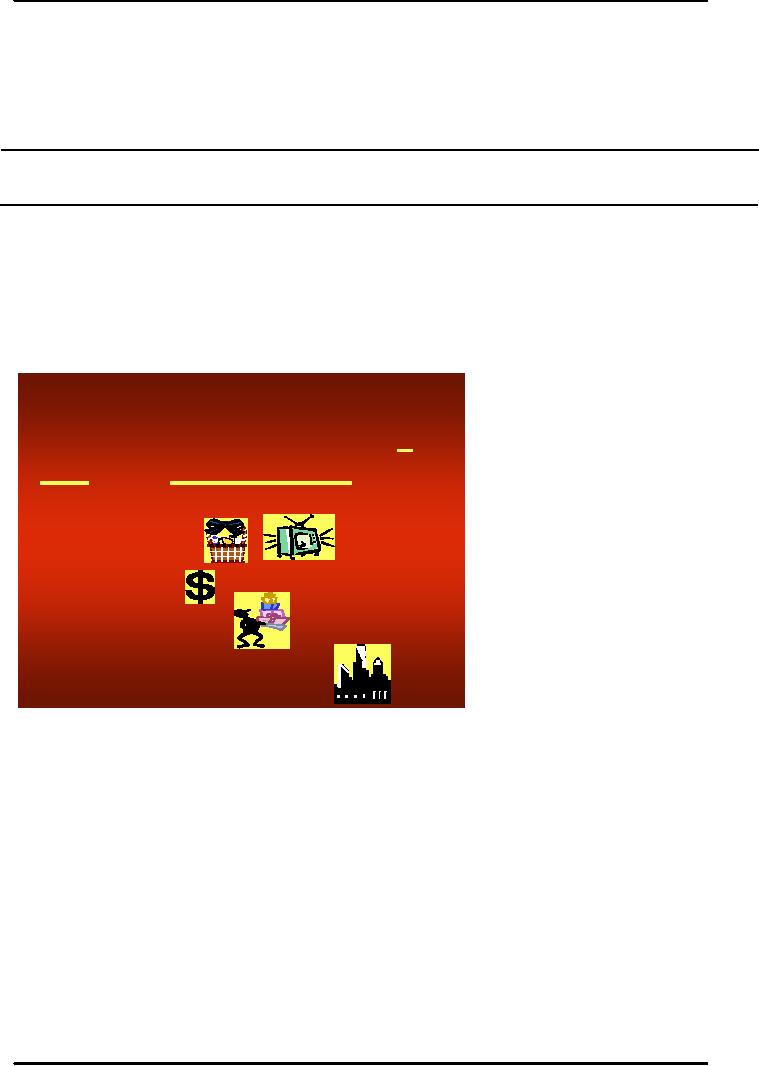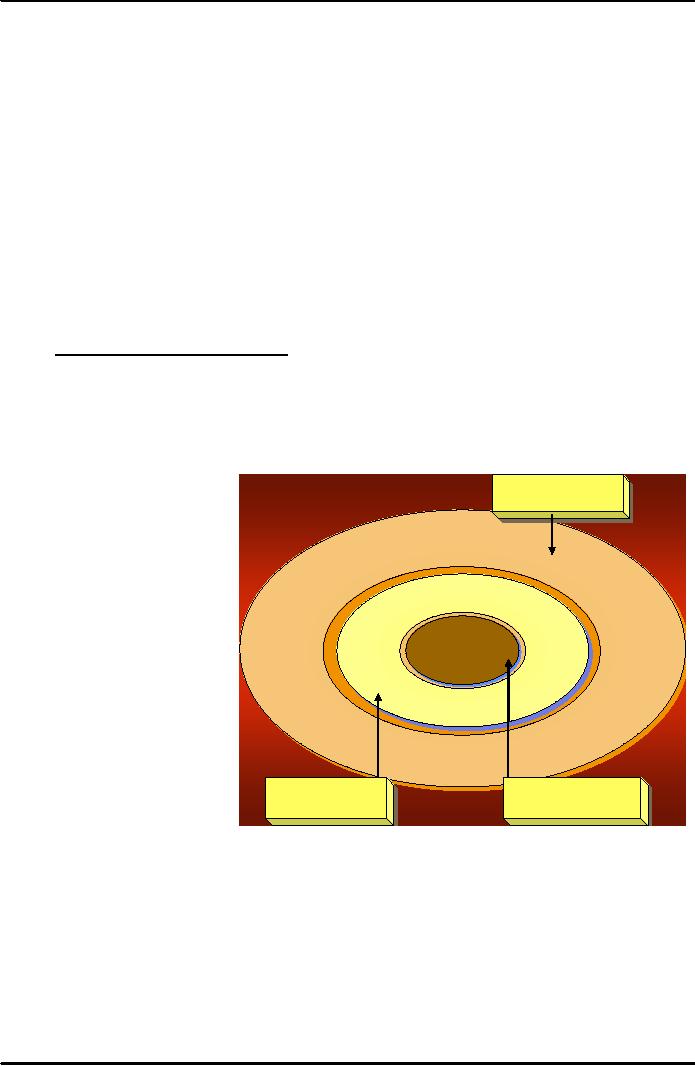 |

Principles
of Marketing MGT301
VU
Lesson
19
Lesson
overview and learning objectives:
In
this chapter we commence an examination
of the marketing mix elements
the so-called 4P's of
marketing,
or if considering the extended marketing
mix, the 7P's of marketing.
1st p of these 4PS
is
Product
is a
complex concept that must be defined
carefully.
A.
4PS
o
Product
a.
Marketing Mix
Marketing
is a process that revolves
around the customers and in
order to meet the
requirements
of
the customer marketers
formulate and design the
marketing mix that is also
known as 4Ps (
Four
marketing activities--product, Price,
Place and Promotion--that a
firm can control to
meet
the
needs of customers within its target
market ). The marketing mix
variables are:
Product:
Goods,
services, or ideas that
satisfy customer needs, Price:
Decisions
and actions that
establish
pricing
objectives and policies
and
set product prices.
Place:
Marketing
is the involved
The
ready, convenient,
and
timely
availability of products
process
of determining the 4
and
finally the Promotion:
P's
of the Marketing
Mix
Promotion
can be defined as
activities
that are used to
inform
customers
about
the
Product
organization
and its products.
These
elements
of
the
Price
marketing
mix and strategies
related
to these elements or
the
variables
are designed by
Promotion
keeping
in view all
the
environmental
factors either
macro
or micro that
can
Place
(Distribution)
influence
the marketing in any
context.
Today is the era
of
value
driven marketing, Value can be defined as
a customer's subjective assessment of benefits
relative
to the costs in determining
the worth of a product. Customer is
ready to pay the cost
of
given
product if that product is of
some value. This value can be determined
as a capability of the
product
to satisfy the customer's needs
and wants.
When
ever customer or the consumer makes
the purchasing decisions they (Consumers)
don't buy
products;
they buy benefits that can
be functional benefits( relating to the practical
purpose a
product
serves) or the Psychological benefits
(relating to how a product makes one
feel) for the
reason
being products are always
purchased in order to fulfill certain
needs that are
definitely
fulfilled
through acquiring certain benefits of the
product. Today, as products
and services become
more
and more commoditized, many
companies are moving to a
new level in creating value
for
their
customers. To differentiate their offers,
they are developing and
delivering total
customer
experiences.
Whereas products are tangible
and services are intangible,
experiences are memorable.
Whereas
products and services are
external, experiences are
personal and take place in
the minds
of
individual consumers. Companies that
market experiences realize that customers
are really
91

Principles
of Marketing MGT301
VU
buying
much more than just
products and services. They
are buying what those offers
will do for
them--the
experiences they gain in purchasing
and consuming these products
and services.
b.
WHAT IS A PRODUCT?
A
product is anything that can
be offered to a market for attention,
acquisition, use, or
consumption
and that might satisfy a
want or need. It includes physical
objects, services,
persons,
places,
organizations, and ideas.' Pure' Services
are distinguished from 'physical'
products on the
basis
of intangibility, inseparability, variability
and perish ability. Services
are a form of product
that
consist
of activities, benefits, or satisfactions offered
for sale that are
essentially intangible and
do
not
result in the ownership of
anything.
Product
is a complex concept that must be
carefully defined. As the first of
the four marketing
mix
variables,
it is often where strategic planning
begins. Product strategy
calls for making coordinated
decisions
on individual products, product
lines, and the product
mix.
a)
Levels of Product and
Services
As
shown in the fig each
product item offered to customers
can be viewed on three
levels.
Therefore
product planners need to think
about products and services
on three levels:
1).
The
core product is the
core, problem solving benefits
that consumers are really
buying
when
they obtain a product or
service. It answers the question
what is the buyer really
buying?
2).
The
actual product may
have as many as five
characteristics that combine to
deliver
core
product benefits. They
are:
a).
Quality level.
Augmentted
Augmened
Prroduct
P
oduct
b).
Features.
c).
Design.
d).
Brand name.
Installation
e).
Packaging.
3).
The
augmented
Packaging
product
includes any
additional
Brand
Features
Name
consumer
services and benefits
Core
Core
After-
Delivery
Benefiit
or
built
around the core and
actual
Benef
t or
Sale
&
Credit
Serviice
Service
Serv
ce
products.
Quality
Design
Level
Therefore,
a product is more
than
a simple set of tangible
features.
Consumers tend to
Warranty
see
products as
complex
bundles
of benefits that satisfy
Acttual
Acual
Corre
Co
e
Prroduct
P
oduct
Prroduct
P
oduct
their
needs.
When
developing
products, marketers
must:
1). Identify the core
consumer needs that the
product will satisfy. 2).
Design the actual
product
and finally 3). Find
ways to augment the product in
order to create the bundle
of
benefits
that will best satisfy
consumer's desires for an experience.
The product. For example,
a
Sony
camcorder is an actual product.
Its name, parts, styling,
features, packaging, and
other
attributes
have all been combined
carefully to deliver the
core benefit--a convenient,
high-quality
way
to capture important moments. Sony
must offer more than
just a camcorder. It must
provide
consumers
with a complete solution to their
picture-taking problems. Thus, when
consumers buy a
Sony
camcorder, Sony and its dealers
also might give buyers a
warranty on parts and
workmanship,
instructions
on how to use the camcorder,
quick repair services when
needed, and a
toll-free
telephone
number to call if they have problems or
questions (augmented
level).
92

Principles
of Marketing MGT301
VU
Therefore,
a product is more than a
simple set of tangible features.
Consumers tend to see
products
as complex bundles of benefits that
satisfy their needs. When
developing products,
marketers
first must identify the
core consumer needs the
product will satisfy. They
must then
design
the actual product and
find ways to augment it in order to
create the bundle of benefits
that
will
best satisfy consumers.
b)
Product Classification
There
are three basic types of
product classifications. Durable
products are used to over
an
extended
period of time. Nondurable products
are more quickly consumed,
usually in a single
use
or
a few usage occasions. 'Pure'
Services are activities or benefits
offered for sale which
are
intangible,
inseparable from the
consumer, perishable in that
they are experiential and do
not result
in
ownership of anything. Either
consumer or industrial customers can buy
each of these
products.
Consumer products are sold to the
final end-user for personal
consumption.
Individuals
and other organizations to use in
their administrative or processing operations
buy
business-to-business
products. Industrial products
are the most widely
used of these products
and
consist
of consumables such as paper clips or
raw materials that are
converted to finished
products.
Lets discuss these
classifications in detail:
I.
Consumer Products
Consumer
products are those bought by
final consumers for personal
consumption. Marketers
usually
classify these goods further
based on how consumers go about
buying them. Consumer
products
include convenience
products, shopping products,
specialty products, and
unsought
products. These
products
differ in the ways consumers
buy them and therefore in
how they are
marketed
�
Convenience
products are
consumer products and services
that the customer
usually
buys frequently, immediately, and
with a minimum of comparison
and
buying
effort. Examples include soap, candy,
newspapers, and fast
food.
Convenience
products are usually low
priced, and marketers place
them in many
locations
to make them readily available
when customers need
them.
�
Shopping
products are
less frequently purchased consumer
products and services
that
customers compare carefully on
suitability, quality, price,
and style. When
buying
shopping products and services,
consumers spend much time
and effort in
gathering
information and making comparisons.
Examples include furniture,
clothing,
used cars, major appliances,
and hotel and motel
services.
�
Shopping
products marketers
usually distribute their
products through
fewer
outlets
but provide deeper sales
support to help customers in their
comparison
efforts.
�
Specialty
products are
consumer products and services
with unique
characteristics
or
brand identification for
which a significant group of buyers is
willing to make a
special
purchase effort. Examples include
specific brands and types of
cars, high-
priced
photographic equipment, designer clothes,
and the services of medical
or
legal
specialists. A Lamborghini automobile,
for example, is a specialty
product
because
buyers are usually willing to
travel great distances to
buy one. Buyers
normally
do not compare specialty
products. They invest only
the time needed to
reach
dealers carrying the wanted
products.
93

Principles
of Marketing MGT301
VU
�
Unsought
products are
consumer products that the consumer
either does not
know
about or knows about but
does not normally think of
buying. Most major
new
innovations are unsought
until the consumer becomes
aware of them through
advertising.
Classic examples of known
but unsought products and
services are life
insurance
and blood donations to the
Red Cross. By their very
nature, unsought
products
require a lot of advertising, personal selling,
and other marketing
efforts.
II.
Industrial Products
Industrial
products are those purchased
for further processing or
for use in conducting a
business.
Thus,
the distinction between a
consumer product and an
industrial product is based on
the
purpose
for which the product is
bought. If a consumer buys a lawn
mower for use around
home,
the
lawn mower is a consumer product. If
the same consumer buys the
same lawn mower for
use
in
a landscaping business, the
lawn mower is an industrial
product.
The
three groups of industrial products
and services include
materials and parts, capital
items, and
supplies
and services. Materials
and parts include
raw materials and
manufactured materials
and
parts.
Raw materials consist of farm
products (wheat, cotton, livestock,
fruits, vegetables)
and
natural
products (fish, lumber, crude
petroleum, iron ore). Manufactured
materials and parts
consist
of component materials (iron,
yarn, cement, wires) and
component parts (small
motors,
tires,
castings). Most manufactured
materials and parts are sold
directly to industrial users.
Price
and
service are the major
marketing factors; branding and advertising
tend to be less
important.
The
demand for industrial
products is derived from the
demand for consumer products.
This is
known
as "derived demand." Capital
items are
industrial products that aid
in the buyer's
production
or operations, including installations
and accessory equipment.
Installations consist of
major
purchases such as buildings (factories, offices)
and fixed equipment
(generators, drill
presses,
large
computer systems, elevators). Accessory
equipment includes portable factory
equipment and
tools
(hand tools, lift trucks)
and office equipment (fax
machines, desks). They have
a shorter life
than
installations and simply aid
in the production
process.
The
final group of business
products is supplies
and services.
Supplies
include operating supplies
(lubricants,
coal, paper, pencils) and
repair and maintenance items
(paint, nails, brooms).
Supplies
are
the convenience products of the
industrial field because
they are usually purchased
with a
minimum
of effort or comparison. Business
services include maintenance
and repair services
(window
cleaning, computer repair)
and business advisory services
(legal, management
consulting,
advertising).
Such services are usually
supplied under contract.
III.
Organizations, Persons, Places,
and Ideas
In
addition to tangible products and
services, in recent years marketers
have broadened the
concept
of a product to include other "marketable
entities" namely, organizations, persons,
places,
and
ideas. Organizations often carry
out activities to "sell" the
organization itself.
Organization
marketing
consists of activities undertaken to
create, maintain, or change
the attitudes and
behavior
of target consumers towards an organization.
Both profit and nonprofit
organizations
practice
organizational marketing. People can also
be thought of as products. Person
marketing
consists
of activities undertaken to create,
maintain, or change attitudes or behavior
toward
particular
people. All kinds of people
and organizations practice person marketing.
Ideas can also
be
marketed. In one sense, all marketing is
the marketing of an idea, whether it is
the general idea
of
brushing your teeth or the
specific idea that Crest
provides the most effective
decay prevention
94
Table of Contents:
- PRINCIPLES OF MARKETING:Introduction of Marketing, How is Marketing Done?
- ROAD MAP:UNDERSTANDING MARKETING AND MARKETING PROCESS
- MARKETING FUNCTIONS:CUSTOMER RELATIONSHIP MANAGEMENT
- MARKETING IN HISTORICAL PERSPECTIVE AND EVOLUTION OF MARKETING:End of the Mass Market
- MARKETING CHALLENGES IN THE 21st CENTURY:Connections with Customers
- STRATEGIC PLANNING AND MARKETING PROCESS:Setting Company Objectives and Goals
- PORTFOLIO ANALYSIS:MARKETING PROCESS,Marketing Strategy Planning Process
- MARKETING PROCESS:Analyzing marketing opportunities, Contents of Marketing Plan
- MARKETING ENVIRONMENT:The Company’s Microenvironment, Customers
- MARKETING MACRO ENVIRONMENT:Demographic Environment, Cultural Environment
- ANALYZING MARKETING OPPORTUNITIES AND DEVELOPING STRATEGIES:MIS, Marketing Research
- THE MARKETING RESEARCH PROCESS:Developing the Research Plan, Research Approaches
- THE MARKETING RESEARCH PROCESS (Continued):CONSUMER MARKET
- CONSUMER BUYING BEHAVIOR:Model of consumer behavior, Cultural Factors
- CONSUMER BUYING BEHAVIOR (CONTINUED):Personal Factors, Psychological Factors
- BUSINESS MARKETS AND BUYING BEHAVIOR:Market structure and demand
- MARKET SEGMENTATION:Steps in Target Marketing, Mass Marketing
- MARKET SEGMENTATION (CONTINUED):Market Targeting, How Many Differences to Promote
- Product:Marketing Mix, Levels of Product and Services, Consumer Products
- PRODUCT:Individual product decisions, Product Attributes, Branding
- PRODUCT:NEW PRODUCT DEVELOPMENT PROCESS, Idea generation, Test Marketing
- NEW PRODUCT DEVELOPMENT:PRODUCT LIFE- CYCLE STAGES AND STRATEGIES
- KEY TERMS:New-product development, Idea generation, Product development
- Price the 2nd P of Marketing Mix:Marketing Objectives, Costs, The Market and Demand
- PRICE THE 2ND P OF MARKETING MIX:General Pricing Approaches, Fixed Cost
- PRICE THE 2ND P OF MARKETING MIX:Discount and Allowance Pricing, Segmented Pricing
- PRICE THE 2ND P OF MARKETING MIX:Price Changes, Initiating Price Increases
- PLACE- THE 3RD P OF MARKETING MIX:Marketing Channel, Channel Behavior
- LOGISTIC MANAGEMENT:Push Versus Pull Strategy, Goals of the Logistics System
- RETAILING AND WHOLESALING:Customer Service, Product Line, Discount Stores
- KEY TERMS:Distribution channel, Franchise organization, Distribution center
- PROMOTION THE 4TH P OF MARKETING MIX:Integrated Marketing Communications
- ADVERTISING:The Five M’s of Advertising, Advertising decisions
- ADVERTISING:SALES PROMOTION, Evaluating Advertising, Sales Promotion
- PERSONAL SELLING:The Role of the Sales Force, Builds Relationships
- SALES FORCE MANAGEMENT:Managing the Sales Force, Compensating Salespeople
- SALES FORCE MANAGEMENT:DIRECT MARKETING, Forms of Direct Marketing
- DIRECT MARKETING:PUBLIC RELATIONS, Major Public Relations Decisions
- KEY TERMS:Public relations, Advertising, Catalog Marketing
- CREATING COMPETITIVE ADVANTAGE:Competitor Analysis, Competitive Strategies
- GLOBAL MARKETING:International Trade System, Economic Environment
- E-MARKETING:Internet Marketing, Electronic Commerce, Basic-Forms
- MARKETING AND SOCIETY:Social Criticisms of Marketing, Marketing Ethics
- MARKETING:BCG MATRIX, CONSUMER BEHAVIOR, PRODUCT AND SERVICES
- A NEW PRODUCT DEVELOPMENT:PRICING STRATEGIES, GLOBAL MARKET PLACE